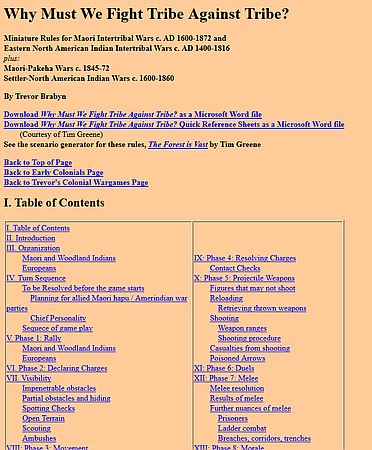
Why Must We Fight Tribe Against Tribe?
Miniature Rules for Maori Intertribal Wars c. AD 1600-1872 and Eastern North American Indian Intertribal Wars c. AD 1400-1816 plus: Maori-Pakeha Wars c. 1845-72, Settler-North American Indian Wars c. 1600-1860
What follows is a set of fast skirmish-level rules for fighting internal conflicts among the Maori tribes of New Zealand and those among Eastern Woodland Indian bands in North America before and during the age of the musket. The idea is to fight the average sort of tribal battle, which took place in dense bush more often than not, involved very small numbers of men, and was very confused and disorganized by western standards, there being no rigid sense of command and discipline. Each player will play a chief, either primary (the main chief who organized the expedition) or subsidiary (helpers to the main chief). The job of the chiefs is not so much to firmly command their men at all points in the battle, but to lead by example, guiding their men to the destination. One way or another, the chiefs of a particular war party must accomplish their objective for the scenario or break the enemy command by bringing it to half strength to win the game. In addition, the earlier "Why Must We Fight Tribe Against Settler?" variant for conflicts involving Europeans has now been merged back into the original rules set, the better to avoid constant flipping back and forth between the two.
– introduction
- Designer
- Trevor Brabyn
- Status
- In Print
- Contents
- Available online (webpage or DOC)
- Scale
The game is intended for use with 25mm figures, mounted individually on ¾" to 1" bases. The figure-to-man scale is roughly 1:2, to fit with the average war party of 100-200 men. The ground scale is 1 inch = 2 yards, based on the principle that the average base of a figure could hold two men if scaled to real life. The general idea is that the terrain should fit well with the figuresí height. The average battle might have about 50-100 figures representing 100-200 real men to a side at this scale, maybe more or less. The scale such that one could do everything on a 1:1 figure scale, depending on the scenario. Games usually last only about two or three hours, but can drag longer depending on the scenario.
– introduction
Back to RULES DIRECTORY
Areas of InterestRenaissance
18th Century
19th Century
Featured Hobby News Article
Featured Link
Top-Rated Ruleset
Featured Showcase Article An unusual addition for your Age of Sail fleets.
Featured Profile Article
|
|










 (8.00)
(8.00)